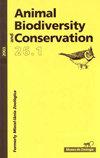Jaguar (Panthera onca) spatial ecology outside protected areas in the Selva Maya
IF 1
4区 环境科学与生态学
Q3 BIODIVERSITY CONSERVATION
引用次数: 0
Abstract
Jaguars (Panthera onca) are endangered in several countries and a priority species for conservation action. Despite extensive research efforts in Mexico most studies have been associated with natural protected areas far from human habitation. Because protected areas are too few to conserve the jaguar population over the long–term, a landscape approach that includes both protected and unprotected lands is needed. This is the case in Quintana Roo State where an ecological corridor linking two protected areas (Yum Balam and Sian Ka'an) is at risk of disappearing due to tourism–driven activities. Between 2013 and 2015, four male jaguars were captured and monitored using satellite telemetry inside the corridor. The mean home range size (± SD) was 101.5 km2 (± 75.9 km2) for the dry season and 172 km2 (± 107.29 km2) for the rainy season. The mean core area size (± SD) was 17.54 km2 (± 16.21 km2) for the dry season and 29.07 km2 (± 16.19 km2) for the rainy season. No significant seasonal differences were found for home ranges or for core areas. As expected, we observed that jaguars preferred forest or young secondary growth over profusely disturbed areas, using whatever vegetation was available in their home ranges. Although it is not protected, a biological corridor linking Yum Balam and Sian Ka'an still holds its own jaguar population, a population that has learned to coexist with human presence. Conservation actions are recommended at landscape level to maintain what remains of tropical mature forest and to promote the development of long–term secondary growth into close tree canopy塞尔瓦玛雅保护区外的捷豹(Panthera onca)空间生态
美洲虎(Panthera onca)在几个国家濒临灭绝,是保护行动的优先物种。尽管墨西哥进行了广泛的研究,但大多数研究都与远离人类居住的自然保护区有关。由于保护区太少,无法长期保护美洲豹种群,因此需要一种包括保护区和非保护区的景观方法。金塔纳罗奥州就是这样,该州连接两个保护区(Yum Balam和Sian Kaan)的生态走廊因旅游业活动而面临消失的风险。2013年至2015年间,四只雄性美洲豹被捕获,并在走廊内使用卫星遥测技术进行监测。旱季的平均家园面积(±SD)为101.5 km2(±75.9 km2),雨季为172 km2(±107.29 km2)。旱季的平均核心区面积(±SD)为17.54平方公里(±16.21平方公里),雨季为29.07平方公里(?6.19平方公里)。家庭牧场或核心地区没有发现显著的季节差异。正如预期的那样,我们观察到,美洲虎更喜欢森林或年轻的次生生长,而不是大量干扰的地区,使用它们家中的任何植被。尽管没有受到保护,但连接Yum Balam和Sian Kaan的生物走廊仍然有自己的美洲豹种群,这种种群已经学会了与人类共存。建议在景观层面采取保护行动,以保持热带成熟森林的残余,并促进长期次生生长到紧密的树冠中
本文章由计算机程序翻译,如有差异,请以英文原文为准。
求助全文
约1分钟内获得全文
求助全文
来源期刊

Animal Biodiversity and Conservation
农林科学-动物学
CiteScore
2.00
自引率
0.00%
发文量
21
审稿时长
>12 weeks
期刊介绍:
Animal Biodiversity and Conservation (antes Miscel·lània Zoològica) es una revista interdisciplinar, publicada desde 1958 por el Museu de Ciències Naturals de Barcelona. Incluye artículos de investigación empírica y teórica en todas las áreas de la zoología (sistemática, taxonomía, morfología, biogeografía, ecología, etología, fisiología y genética) procedentes de todas las regiones del mundo. La revista presta especial interés a los estudios que planteen un problema nuevo o introduzcan un tema nuevo, con hipòtesis y prediccions claras, y a los trabajos que de una manera u otra tengan relevancia en la biología de la conservación. No se publicaran artículos puramente descriptivos, o artículos faunísticos o corológicos en los que se describa la distribución en el espacio o en el tiempo de los organismes zoológicos.
 求助内容:
求助内容: 应助结果提醒方式:
应助结果提醒方式:


